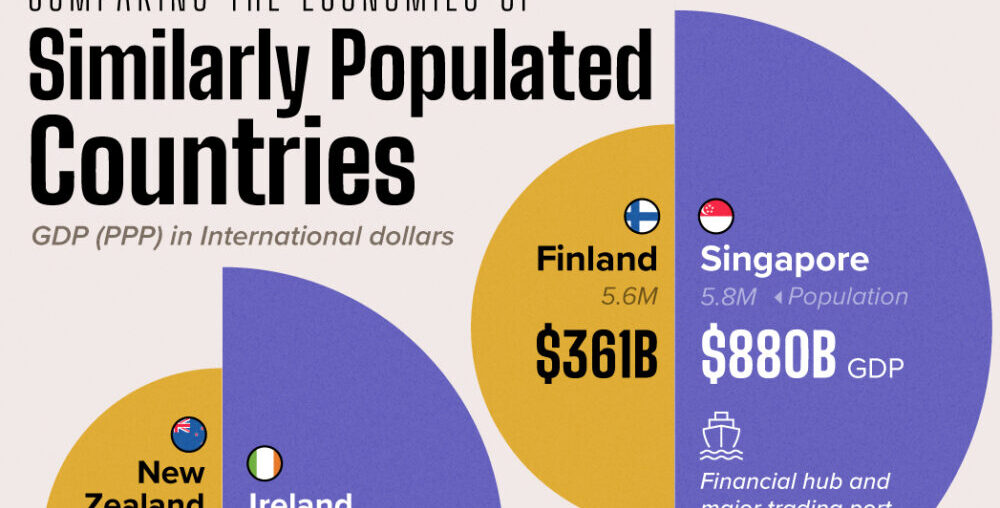How Similarly-Populated Countries Compare in Economic Strength
This was originally posted on our Voronoi app. Download the app for free on iOS or Android and discover incredible data-driven charts from a variety of trusted sources.
Comparing a country’s economic strength with another often requires footnotes to account for population size and its impact on demand. But for countries with similar populations, comparisons can proceed footnote-free.
Thus, we visualize five pairs of countries with similarly-sized populations but significantly different GDPs, even when accounting for purchasing power parity.
PPP-adjusted metrics reduce the impact of exchange rate fluctuations on GDP, thus evening out comparisons a little.
Data for this graphic is sourced from the International Monetary Fund and the United Nations, as of October 2024. All figures are in International dollars (Int$).
Same Populations, Different GDPs
Singapore’s significantly higher GDP compared to Finland, despite similar population sizes, is largely due to its strategic position as a global financial hub and major trading port.
For example, the Port of Singapore handles over 37 million shipping containers annually. In contrast, Finland’s Port of Helsinki averages half a million.
| Country | GDP (PPP, Int$) | Compared to | GDP (PPP, Int$) |
|---|---|---|---|
| 🇫🇮 Finland (5.6M people) |
$361B | 🇸🇬 Singapore (5.8M people) |
$880B |
| 🇳🇿 New Zealand (5.2M) | $284B | 🇮🇪 Ireland (5.2M) | $692B |
| 🇬🇪 Georgia (3.8M) | $102B | 🇭🇷 Croatia (3.8M) | $187B |
| 🇹🇱 Timor-Leste (1.4M) | $6B | 🇲🇺 Mauritius (1.3M) | $40B |
| 🇧🇹 Bhutan (786K) | $13B | 🇬🇾 Guyana (826K) | $63B |
Meanwhile, Ireland’s success in attracting multinational corporations through favorable tax policies and its strategic position as a gateway to the European market has resulted in substantial foreign direct investment.
Of course, some creative GDP accounting, dubbed “leprechaun economics” may have also impacted calculations here. As of 2024, its PPP-adjusted GDP is nearly 2.5 times that of similarly-populated New Zealand.
Perhaps most interesting is Guyana, whose 2015 oil discovery has transformed the economy. That year it had the same PPP-adjusted GDP as Bhutan (roughly $7 billion). Since then Guyana’s economic output is up more than nine-fold, now at $63 billion per year.
Learn More on the Voronoi App 
Interested in more economic comparisons? Check out The Biggest Wealth Gaps Between Neighboring Countries— some of them with access to the same natural resources.

